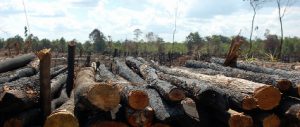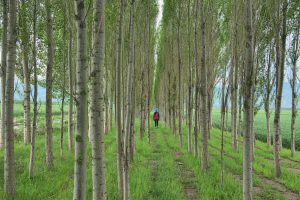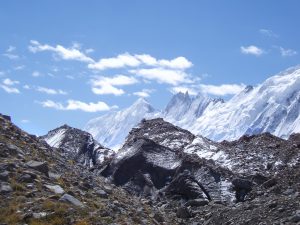China is one of the world’s most forested nations, but many of those forests are in poor health. The number of large, healthy trees over one metre in diameter is falling, while the proportion of younger trees is rising. There is a lack of diversity, density is low and carbon storage levels are relatively poor. All these problems can be linked to long-standing forest fire controls.
China plans to expand the area of the country covered by forests from 20% of total territory today to 25% by 2050. “And that’s as high as it can go,” said Chen Jianwei, a forest conservation expert at the State Forestry Administration (SFA). China has a population of 1.4 billion, and some land needs to be retained for farming and other uses. That makes maintaining healthy, high-quality forests even more important.
For China’s forestry authorities, forest development and forest fire are in direct conflict. A fire discovered in any of China’s forests will be extinguished immediately and many forests have not seen a fire for decades. But in the United States, fire is commonly used as a means of keeping forests healthy.
Two years ago, forest-fire experts at The Nature Conservancy (TNC), the US green NGO where I work, accepted an invitation to visit Beijing Songshan Nature Reserve to look at forest health issues. During their visit to this protected forest, they were shocked to discover that the largest Chinese pine was no more than 50 or 60 centimetres in diameter, and that the forest in general was in poor health. They suggested using controlled burnings to improve the forest. The Chinese forestry officials said that, while they understood the proposal, it would be impossible for them to follow it – in fact, it would be illegal.
Some officials and experts have suggested it could be possible to trial the use of small, controlled fires in suitable and well-managed forests. But a fire that ran out of control would likely end careers, and so everyone continues to do everything possible to prevent fires.
The small city of Ashland, Oregon, in the western United States, is surrounded by wooded mountains which provide a model of good forest-fire management. The city government has been working closely with the TNC for four decades, using forest fires to maintain this ancient and flourishing virgin forest.
Scott Conroy is forest supervisor in Siskiyou county and guardian of 800,000 hectares of government-owned forest, home to more than 500 redwood trees, the world’s largest living organism. Over 30 metres tall – with some giants towering over 50 metres – these trees can reach hundreds of years, even more than a thousand years, in age. These trees have not just survived numerous forest fires, they have flourished. Some have lower trunks scorched black by earlier fires, but retain luxuriant green crowns. One has a hole in its trunk big enough to drive through. Conroy said the longevity of these trees is in part due to forest fires.
Redwood bark contains high levels of tannic acid, which gives it natural resistance to fire. Fires, often caused by lightning, remove dead branches and trees and eliminate the redwood’s competitors. Once they have plenty of sunlight, the redwoods become king of the forest. Every giant redwood cone has 200 seeds, but these will only be released after the cone is dried out by forest fire. Conroy explained that this is the case with many conifers. “Forest fire is an important part of the ecosystem, and it has a huge impact on the make-up of forest plants, and on forest birds and animals.”
Conroy pointed to a redwood forest 2,500 metres up in the Siskiyou Mountains, explaining that this part of the Claremont Mountain Range is particularly favoured by nature. A number of ecosystems meet here, including the continental and North Pacific climates, it is near the coast, escaped the effects of the fourth ice age and is home to a rich diversity of vegetation, including a kingdom of conifers: 17 types in a 200 hectare forest. In a healthy ecosystem, different types of trees, vegetation and animals all flourish. “Forest fires were a major factor in creating that,” said Conway. “Mountains, glaciers, waterfalls, cliffs and all kinds of wild animals, all created that healthy forest ecology – and forest fires give them life.”
America hasn’t always understood and made use of forest fires in this way. Some 150 years ago, European colonists arriving in the region were moved by the tall redwoods and luxuriant woodlands. The government passed laws protecting the area, with a particular focus on fire-prevention. Like China today, the authorities saw fire as the major threat to the forests.
But a century later, people were surprised to discover that their work to prevent fires was actually resulting in less healthy forests – there were fewer young redwoods, fewer tall, strong trees and the forest was full of saplings, scrub, grass and pests.
Kerry Metlen, a TNC forest ecologist, showed me a large cross-section of a redwood killed in a huge forest fire in 1810, the tree’s age rings and traces of fire damage clearly visible. “This tree sprouted in 1388 and survived 18 forest fires,” he said.
Metlen and colleagues carried out a rigorous analysis on the trees in this section of woodland as part of a research project on the history of forest fire. They collected data on which years had seen major fires; which species were affected and to what extent; which trees died and which trees sprouted, all of which produced the following conclusion: there should be a major forest fire every 12 years. Natural forest fires allow forests to retain the ability to recover. “Unfortunately, our misguided intervention means there have been no major fires since 1860,” said Metlen.
When redwood saplings are surrounded by other trees, the light they need to grow is blocked out and they stay small. A covered environment is a disaster for the redwood. And so, starting in the 1970s, the area started to experiment with controlled fires to help the woodland recover.
The Nature Conservancy purchased two private forests and, together with the forestry authorities, identified 10 areas totalling 2,000 hectares for forest-fire trials. First, old branches, fallen leaves and small trees were removed and felled trees taken away by helicopter. Firebreaks – gaps in vegetation – were created around the trial areas. Since then, a fire has been set every few years.
Fires provide wild animals with light, grassy areas, wild flowers and fruits and large trees, and make the forests richer and more diverse. The health of a forest is not measured by the number of trees. After all, some trees need lots of space to grow in and a forest consisting only of young trees may not survive a fire. Because of this, in American forests you often see blue marks on tree trunks, signalling that experts have selected these trees for felling.
Oregon’s forest-management techniques may seem strange to many Chinese. China is overhauling its forestry rights system and, apart from a small number of forests in national reserves, most woodland is in farmers’ hands. Given China’s complicated forest ownership arrangements, it is impossible to know how long it will it be before we can start to apply forest fires in this way. Perhaps we first need further reform of China’s forest management systems and laws.
Zhang Kejia is press officer at The Nature Conservancy and a former reporter for China Youth Daily.
Homepage image by Proper dave



